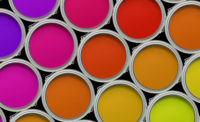From the Heart of Africa to the Modern-Day Oil Patch, Paints Have Come a Long Way

Archeologists claim paint ingredients were found in Africa that date back 350,000 to 400,000 years ago. It is thought the Chinese were lacquering away some 7,000 years ago. Later, the Druids invented a durable ox blood and lime mixture, and the Egyptians applied waterproof coating to their wooden boats made from pitch and balsam 3,000 years.
Much of the original incentives for coating, daubing really, were for wall, face and arm decorations, but as Man became more sophisticated the need for durability became paramount particularly in such activities as seafaring where you did not want your boat sinking beneath you or becoming waterlogged.
Today, so much about coatings involves complex chemistry that has resulted in coatings that subsequently turned out to have dire consequences.
Castagra CEO Peter Roosen observed, “Parts of the world are still suffering from the remnants of coatings that contained extremely toxic levels of lead. The Centers for Disease Control and Prevention (CDC) recently took blood samples from 1,653 kids and about 50 of whom got unfavorable test results.The CDC estimated the total number of American households contaminated with lead at four million.”
Today, with a maximum five micrograms threshold, the number of kids potentially poisoned with lead is estimated at over 500,000 children, meaning about one in 38 children under six.
Roosen said that lead is not the only danger out there for children. “Asbestos is still in many old schools, and a number have been permanently closed in cities such as Pittsburgh.”
Even during renovations, still too many coatings have levels of VOSs and solvents used that remain worrying.
“I suppose that was a couple of the factors that drove us to create a vegetable oil-based coating that is completely non-toxic, VOC- and BPA-free, has a Class A fire rating and neither contains solvents nor uses them in applications or post coating cleanup,” said Roosen.
Castagra’s Ecodur is made from mostly castor oil and a naturally occurring non-toxic mineral gypsum. When plasticized, it can be manually applied or sprayed and can even be foamed. It also has an ANSI-NSF-61 rating for use in contact with potable water.
“It sticks like crazy, even to Teflon, but with wood and natural fibers, it actually bonds molecularly making it only removable by blasting or machining off; it’s that tough.”
Ecodur has made major inroads into the oil and gas industries, especially in Texas and Oklahoma, where its ability to outperform conventional epoxy coatings in terms of chemical and shock resistance has gained considerable traction with companies involved in fracking.
“We have coated many hundreds of oil tanks that hold a vast variety of contents, chemically speaking. The fracking industry has thrown up enormous challenges for the coating industries, most particularly the chemicals being used, some of which literally devour unprotected steel.
“And it’s not just chemical resistance that has to be factored in. The oil and gas patches are brutally rough on equipment and not just from the harsh extremes of climate. Unmade roads mean whenever equipment is moved, it get highly stressed so that conventional epoxy coatings rapidly micro-crack, allowing in acidic moisture to wreak havoc.”
Roosen said he can’t forget the time he was on the deck of six-month-old German-built ferry in Canada when he observed rust stains already emerging along weld seams that had been given a conventional epoxy coating that had clearly failed.
“The coating world is one of extremes, and we chose one of the toughest with the oil and gas industry because we had shown how well we did with deck coatings using our plasticized gypsum on a fleet of C-Class ferries.
“As the industry drives forward to minimize the use of solvents and VOC levels, we got there by focusing on using natural products as the prime ingredients and inventing a spray head that can be cleaned with just a routing tool or simply replaced.
“None of this was easy, and a 25 year antecedent history brought us through trials and testing to where we are today with a unique, natural chemistry for coatings that’s about as robust as they get for the tough world out there," concluded Roosen.
Looking for a reprint of this article?
From high-res PDFs to custom plaques, order your copy today!







